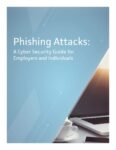 Phishing attacks are on the rise, and threaten the cybersecurity of firms large and small. The best defense against any type of cybercrime is education. Understanding the threat and having your employees understand the threat will help lessen the chances that hackers can infiltrate your network.
Phishing attacks are on the rise, and threaten the cybersecurity of firms large and small. The best defense against any type of cybercrime is education. Understanding the threat and having your employees understand the threat will help lessen the chances that hackers can infiltrate your network.
Our guide on phishing attacks will help give you and your team a thorough understanding of the risks this threat presents to your organization.
Here are some highlights:
What is a phishing attack?
In broad terms, hackers go on a “fishing expedition” by sending millions of emails to unsuspecting receivers hoping they will click a link, open a file, or enter private information into fraudulent websites. The result can be loss of money, credit card fraud, identity theft and more.
It doesn’t matter the size of your organization – large and small firms are hit by these attacks daily. Hackers play the odds by sending huge volumes of emails out hoping for that click-through which will give them the opportunity to steal money or seize a network. Like baiting a hook and dropping a line in the ocean you don’t know if you’ll catch a large fish or small one – for hackers size doesn’t really matter, it’s just the catch that matters to them because each catch can be monetized.
Hackers have upped their game and created sophisticated email schemes to trick receivers into believing that the emails are authentic and warrant them clicking through dangerous links.
The Ponemon Institute reports that human error accounted for nearly 30% of worldwide data breaches – this tells me that cyber risk education is paramount.
Think your anti-virus or spam blockers will prevent an attack? Think again, most phishing messages bypass filters and anti-virus software and arrive in your employee’s inbox like hundreds of other emails every day. Cybercriminals rely on psychology and misdirection to get employees to click harmful links.
What’s the solution?
As I mentioned, continued education and regular discussion of these threats is important. While this guide is lengthy, it’s not required to be read cover to cover. Flipping through it will engage your team, and get them to understand what to look for and how sophisticated these attacks have become. If you wish to take certain sections out and specifically send them to your team to train on phishing attack risks, you can do that as well.
Ultimately though, your company is at risk and may become a victim of a cyber event. Whether it’s the theft of funds, theft of private information, or the total seizure of your network, the costs can be extremely high. That’s why cyber insurance is a must today. Cyber insurance can not only respond to the immediate threat, but the consequential loss caused by infiltration, notification costs, and data remediation costs.
If you’ve held off on buying cyber, for whatever reason, I believe now is the time to make the decision to purchase protection. The threats continue to escalate, the potential for loss is very significant, and the cost of coverage is relatively low. In fact, obtaining coverage has never been easier.


